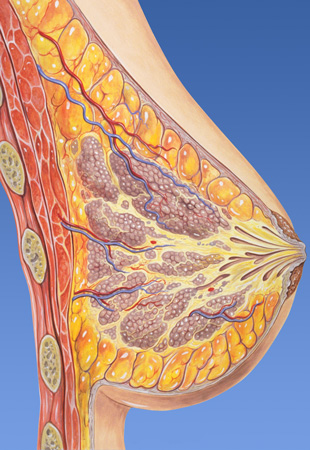To prevent your breasts from sagging as you get older, it’s useful first to recognize what causes the issue in the first place.
Breasts themselves do not contain bone or muscle and instead are mostly sacks of fat, milk producing glands and connective tissue. Sagging normally begins at around the age of 40 and this is mostly problematic for women who have been pregnant.
 The specific cause in most cases is that the aforementioned connective tissue has become stretched and lost its strength and elasticity. If you think of the breasts as footballs held up by elastic bands (a beautiful metaphor, I know) these elastic bands can start to stretch and lose their strength over time, causing the footballs to get lower and lower to the ground.
The specific cause in most cases is that the aforementioned connective tissue has become stretched and lost its strength and elasticity. If you think of the breasts as footballs held up by elastic bands (a beautiful metaphor, I know) these elastic bands can start to stretch and lose their strength over time, causing the footballs to get lower and lower to the ground.
The heavier your breasts are, the more likely this is as the more tension there will be on the connective tissues throughout the day. This is why pregnancy is a risk factor – as women will then gain weight very quickly, increasing the strain on their ligaments and leading to the stretching and loss of elasticity.
Weight Loss
If you’re currently starting to notice your breasts hanging lower, then the best immediate solution is to try and lose weight. Losing weight will cause the breasts to become immediately lighter and this then will mean that less tension is required to keep them perky. If you look at women with smaller breasts, they are much less likely to experience sagging – and the best way to make your breasts smaller is to lose weight.
You can’t target fat loss which means you might have to lose weight from other areas of your body before it sheds from your bust. This does at least keep things simple though: any exercise that burns calories and especially high intensity interval training will trigger the change you’re looking for.
Support
Gaining weight is fairly unavoidable during pregnancy though and this is why ‘previous pregnancy’ is a big risk factor for sagging breasts.
Thinking ahead then, what can you do to minimize the damage? One option is to wear a supportive bra throughout which will help to prevent the strain from being solely on the ligaments.
Of course when you’re older and you’re already dealing with sagging breasts, you can also use supportive underwear to create the illusion of a perkier pair and this can also help to avoid the problem from getting too much worse.
Breast Exercises
While there are no muscles in the breast, there is plenty of muscle right underneath. This is where your pectoral muscles can be found and it’s these that your breasts are attached to via your ligaments. By training your pecs you can this way raise the platform that the breasts are attached to which will have immediate positive effects. At the same time, exercising the pecs means that your muscles won’t also be sagging and it helps to tone and firm the area. Take a look at some female bodybuilders and you’ll notice that many of them have quite man-like chests. That might not be what you’re going for but it’s certainly a step in the right direction in this instance.
You can also focus on exercise that will improve your posture and specifically roll your shoulders back and help you to stand more upright. This will immediately make your breasts look perkier while also making you look taller and more confident.
To achieve this, focus on exercises that strengthen your lats, your traps, your posterior deltoids and your erector spinae (lower back). Stretching your pecs can also help to improve in this regard.
Nutrition
Finally, make sure that you are eating a healthy and balanced diet. In particular, you should aim to focus on increasing your intake of calcium, magnesium, protein and vitamin C. By doing this, you can help your body to naturally rebuild and strengthen your connective tissues which will help to put some tensile strength back in your boobs.
Follow these strategies and you might just find you start to feel rather uplifted!



